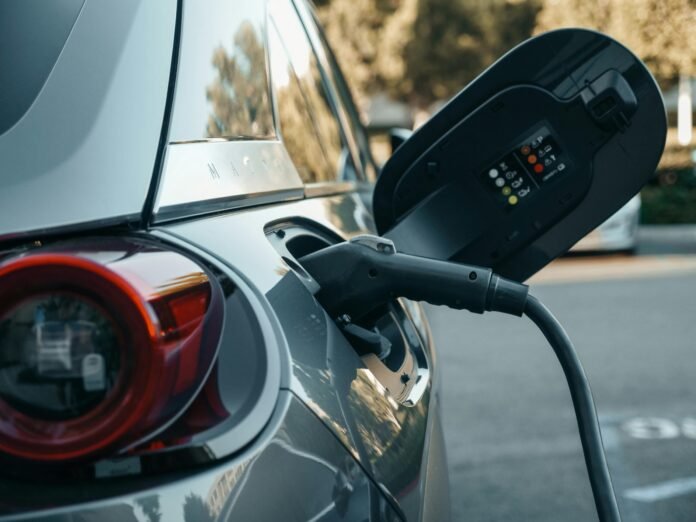Startup profile: ElectroTempo
- Founded by: Patrick Finch and Ann Xu
- Year founded: 2020
- Headquarters: Ballston, VA
- Sector: Clean energy, analytics
- Funding and valuation: $5 million. Seed round valuation: $15.5 million post-money
- Key ecosystem partners: Virginia Innovation Partnership Corporation, Port of Virginia
An Arlington startup is helping utility companies, ports and counties across the US boost vehicle electrification through predictive analytics.
ElectroTempo in Ballston hosts platforms that can advise users on where and how to invest in electric vehicle chargers and infrastructure. Its tools help guide decisions with data localized down to the street block level.
The tech pulls information from property tax records, business documentation and census research. It also overlays data from satellite imagery showing EV trips. AI is a key contributor to the predictions made with this information, explained cofounder and COO Patrick Finch.
These detailed analytics help people make informed decisions about investing in electrification infrastructure, which is key for widespread adoption, he said.
“If people don’t make money off the electric transition, then it’s not going to happen, or it’s going to happen more slowly,” Finch told Technical.ly.
He describes the products as digital twin technology to model how regions operate today and how functions will change with X number of electric vehicles added — not to mention how all that impacts the grid, given the growing concerns about power availability.
“We want to be the analytics backbone that allows large-scale operation of an electric charging network,” Finch said.
Funding from the feds — a former employer
Founded in 2020, ElectroTempo has landed deals with 13 customers, including real estate logistics firm Prologis, Broward County in Florida, the Port of Virginia and the transportation electrification nonprofit Calstart.
Calstart and ElectroTempo recently announced a partnership to electrify freight transport along the I-95 highway from New Jersey to Georgia.
In April, the firms nabbed a $1.2 million grant to support this work. The money came from a place familiar to both Finch and his cofounder Ann Xu: the Department of Energy (DOE).

Finch and Xu, the company’s CEO, met while working at the DOE’s Advanced Research Projects Agency – Energy. Finch realized during this time that encouraging people to use public transportation or other energy solutions doesn’t help as much as one would think. The US is laid out for driving, he said, so electric vehicles need to be a part of the clean energy solution.
That’s where the idea for ElectroTempo came in, per Finch.
“If you can’t decarbonize passenger vehicles, then you’re not going to get any meaningful reductions in emissions from the transportation sector,” he said. “If you can’t electrify the supply chain — on the medium, heavy-duty vehicle side — you’re really not going to scratch the surface of reducing emissions.”
The company also pulls money from a mix of existing private investors, including Chicago’s Buoyant Ventures, San Francisco’s Schematic Ventures and Zebox Ventures in France. ElectroTempo plans to build on that by raising a Series A in 2026, per Finch.
Tech considers times of day, flood zones
For ElectroTempo’s work with Broward County, part of the Miami metro area, Finch and his team of eight (plus cofounder Xu) are mapping the number of chargers needed to meet that electric vehicle demand, and the sufficient investment to fund that charging requirement.
He’s also outlining which times of day are peak times for charging, as well as flagging flood zones where chargers may not be ideal, he said. Essentially, they’re figuring out how many chargers to put where and evaluating what’s most cost-effective.
For example, if demand for EV chargers will rapidly increase in the next 10 years, it’s better to set them up upfront rather than one at a time, Finch explained.

This detailed data is important to prove to government leaders, investors and those in the private sector that EV investment is a boon for them, he said.
“It’s a chicken or egg problem, right?” Finch said. “Without good forecasting tools to go to the property developers to say, ‘Look, the demand will materialize if you put in the chargers,’ it’s really hard to get people to commit to any sort of investment.”
Going forward in Trump territory
ElectroTempo staff are monitoring the volatile and ongoing tariff and trade actions between President Donald Trump and other global leaders — and how that’ll affect parts and EV imports.
This administration has also been retreating from clean energy incentives and policies. Trump’s tax bill, passed by the House of Representatives in May, makes clean-energy-related tax credits more difficult to access.
Finch wishes for more certainty about clean energy programs in the US, but said that ElectroTempo’s platform alleviates the pressures of the unknowns.
“In the absence of certainty, our software can be a really helpful tool,” Finch said, “because we can actually model those scenarios and help you try to find a reasonable alternative to doing nothing.”






